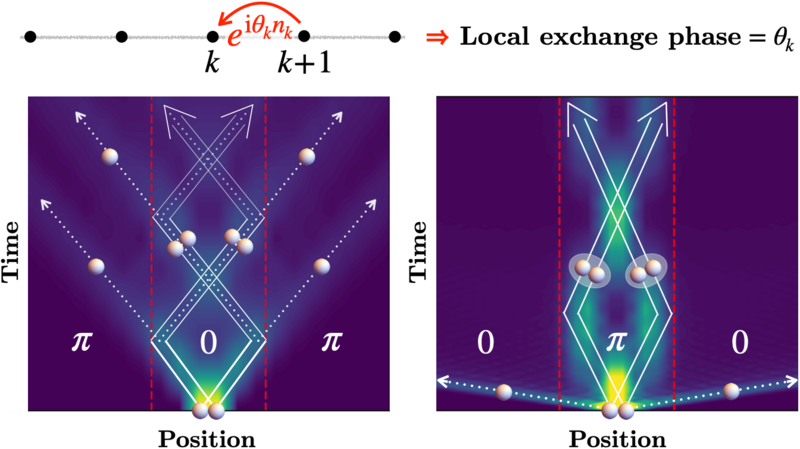Research Highlights
Particles that mutate by moving from place to place
The authors show how one can coax the same quantum particles to behave as bosons in one region and (pseudo)fermions in another, opening up a rich class of controllable many-particle dynamics.

How two particles move through bosonic (“0”) and fermionic (“π”) regions: Left. The particles start out as bosons and move together (solid lines) left and right before impinging on a 0-π border, where they are partially reflected (solid lines) and partially split (dotted lines). For each splitting, one particle escapes the bosonic region. Right. Starting as pseudo-fermions, the particles move in a superposition of two ways: in one, they rapidly move apart as ordinary fermions and pass straight through the π-0 borders (dotted lines); in the other, they are bound together, move very slowly, and are trapped in the fermionic region (solid lines).
All fundamental particles fall in two groups: fermions (“matter particles”), which avoid each other, and bosons (“force carriers”), which like to be together. In condensed-matter settings, it is also possible to have quasi-particles that behave in between bosons and fermions, called “anyons,” which are potential hardware for robust quantum computers. In one dimension, the distinction between these groups is somewhat loose, i.e., one can map a system of bosons to a system of fermions and vice versa. However, in the setups explored so far, the nature of the particles could not vary in space or time.
The present study shows that, by applying an effective magnetic field that varies in space and with the particle density, one can make the same particles behave like bosons, fermions, or anyons in different spatial domains. Depending on how these domains are arranged, one finds strikingly different collective motion, including fragmentation or trapping as shown in the figure. A particularly notable feature is that the domain walls are intrinsically “many-body” — they are transparent to single particles, yet can dramatically alter the particle distribution by how they reflect or split bunched particles arriving together.
This intriguing scenario can be realised in existing optical-lattice setups, where one can design correlated transport phenomena with potential technological applications.
Liam L.H. Lau and Shovan Dutta, Phys. Rev. Research 4 L012007 (2022).
Adapted from a Cavendish press release.